NUR272 Nursing: Ataxia Management Care Plan & S/E Framework
VerifiedAdded on 2023/06/12
|11
|2755
|172
Report
AI Summary
This nursing assignment focuses on developing a care plan for a patient named Sherry, who suffers from ataxia. The plan utilizes the socio-ecological framework to address the patient's needs at various levels, including personal, interpersonal, organizational, and community. It emphasizes the importance of physical activity, social support, health literacy, and community resources in managing ataxia symptoms and improving the patient's quality of life. The care plan includes strategies for self-management, such as exercise programs, counseling, and the use of adaptive equipment, all aimed at empowering the patient to live more independently and improve her overall well-being. The assignment also highlights the role of nurses, family members, and community support in providing comprehensive care and support to individuals with ataxia.
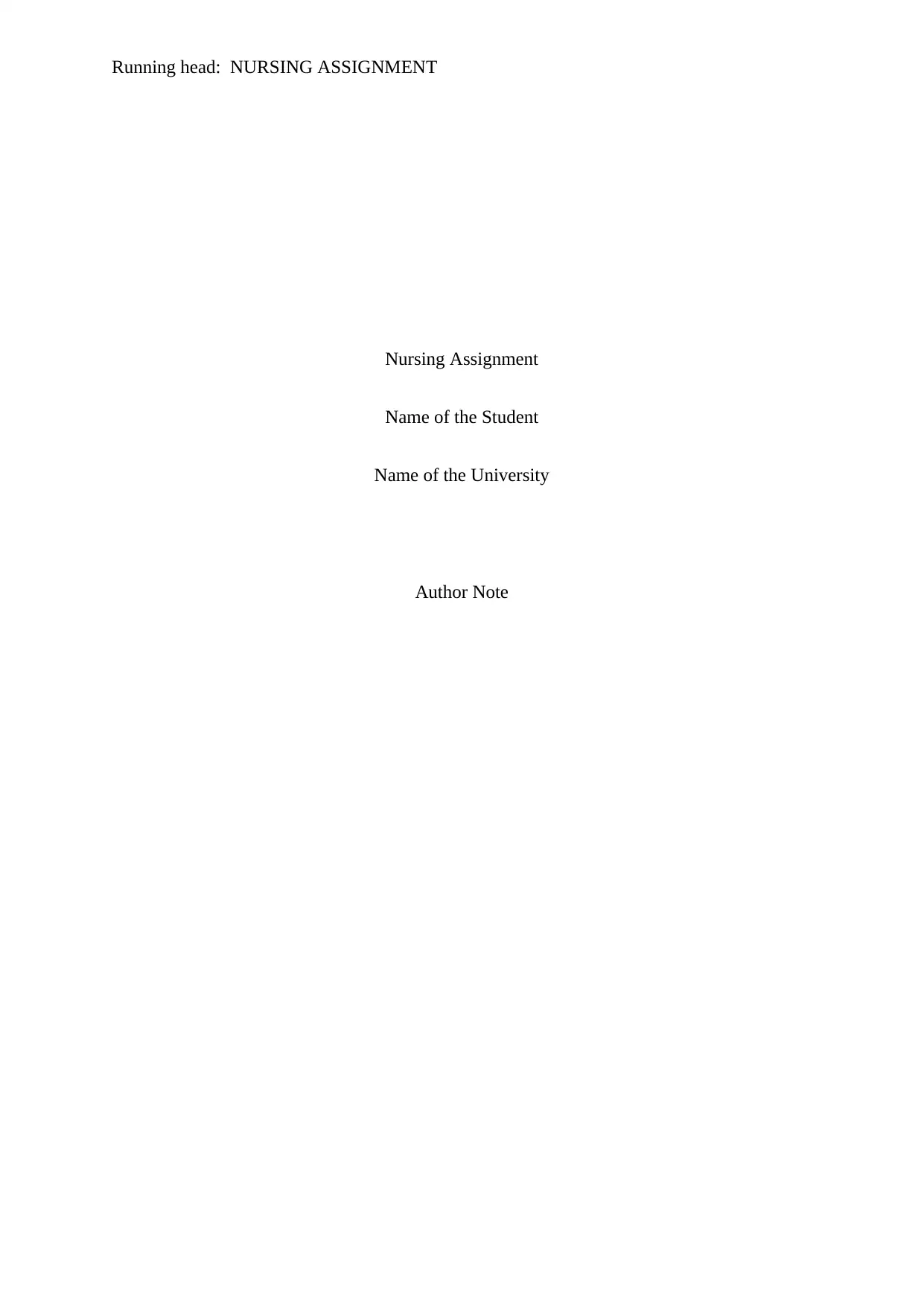
Running head: NURSING ASSIGNMENT
Nursing Assignment
Name of the Student
Name of the University
Author Note
Nursing Assignment
Name of the Student
Name of the University
Author Note
Paraphrase This Document
Need a fresh take? Get an instant paraphrase of this document with our AI Paraphraser

1
NURSING ASSIGNMENT
The Prelude
The Patient name is Sherry and she is from Bundaberg. The Patients identified health
condition is Ataxia and will undergo the procedure of lumber puncture for further diagnosis.
The imaging test performed and their results were CT(abnormal), MRI of the brain(-ve), MRI
spinal (normal) and thoracic spine MRI (-ve). The symptoms experienced by the patient are
balanced problems, misaligned gait, vision difficulties and poor coordination. The symptoms
are affecting her ability to perform daily life activities .The patient works at public hospital as
a Registered nurse and has experienced through the diagnostic processes during her practice.
Sherry engages in various physical activities to keep herself healthy however the symptoms
are restricting her from performing physical activities. The symptoms poor coordination,
balance problems, vision difficulties and broad gait are experienced by the Patient. Thereby,
the patient experience struggles in performing her routine activities at work and home. Sherry
s mother is her social support. She has high health literacy however she is experiencing the
feeling of uncertainty. The identified health goal is to manage the symptoms of ataxia which
will improve the quality of life of the patient. The empowerment of the patient in self-
management of symptoms, use of certain therapies and adaptive devices can ease the
symptoms and increase the independency of the patient.
NURSING ASSIGNMENT
The Prelude
The Patient name is Sherry and she is from Bundaberg. The Patients identified health
condition is Ataxia and will undergo the procedure of lumber puncture for further diagnosis.
The imaging test performed and their results were CT(abnormal), MRI of the brain(-ve), MRI
spinal (normal) and thoracic spine MRI (-ve). The symptoms experienced by the patient are
balanced problems, misaligned gait, vision difficulties and poor coordination. The symptoms
are affecting her ability to perform daily life activities .The patient works at public hospital as
a Registered nurse and has experienced through the diagnostic processes during her practice.
Sherry engages in various physical activities to keep herself healthy however the symptoms
are restricting her from performing physical activities. The symptoms poor coordination,
balance problems, vision difficulties and broad gait are experienced by the Patient. Thereby,
the patient experience struggles in performing her routine activities at work and home. Sherry
s mother is her social support. She has high health literacy however she is experiencing the
feeling of uncertainty. The identified health goal is to manage the symptoms of ataxia which
will improve the quality of life of the patient. The empowerment of the patient in self-
management of symptoms, use of certain therapies and adaptive devices can ease the
symptoms and increase the independency of the patient.
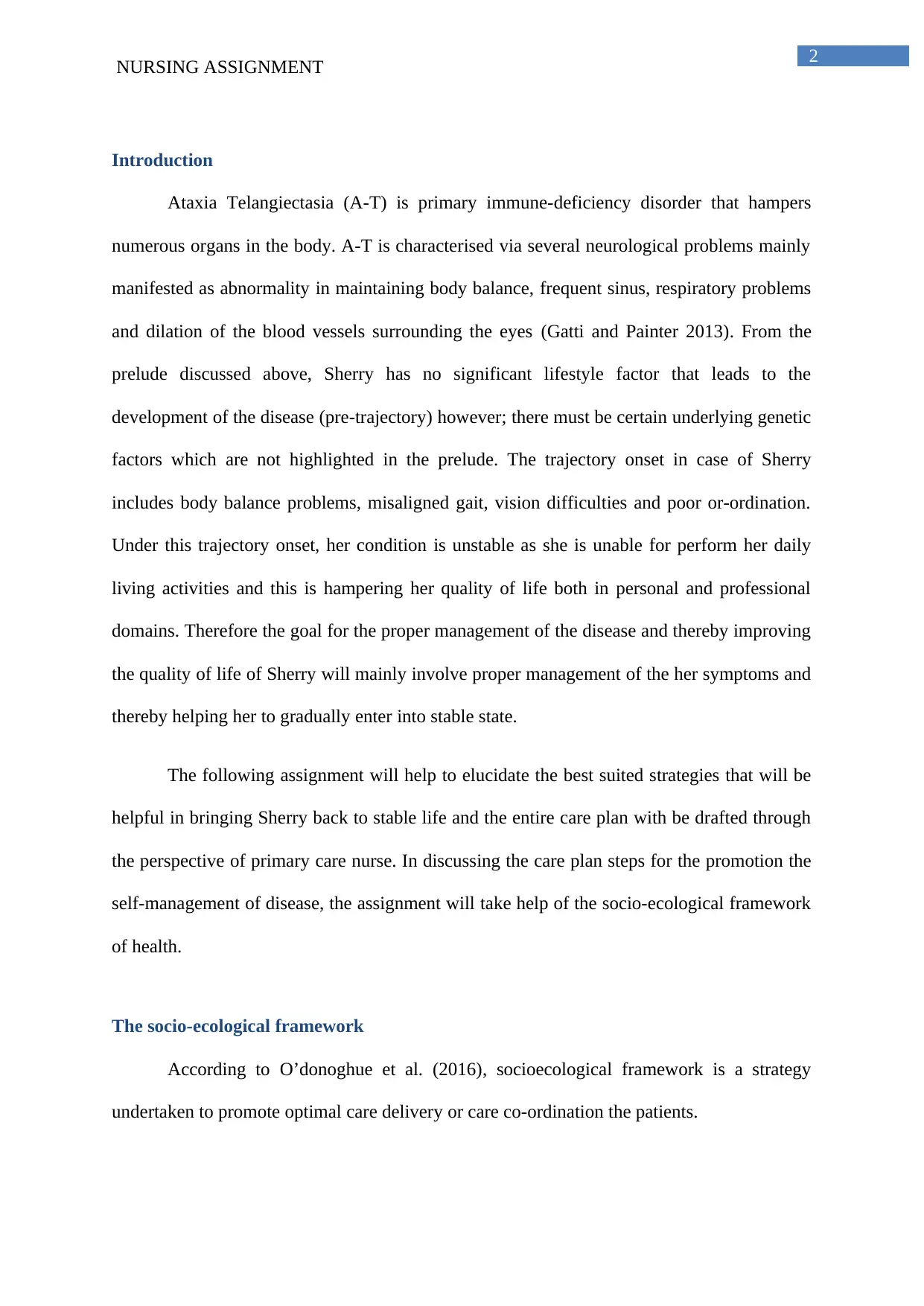
2
NURSING ASSIGNMENT
Introduction
Ataxia Telangiectasia (A-T) is primary immune-deficiency disorder that hampers
numerous organs in the body. A-T is characterised via several neurological problems mainly
manifested as abnormality in maintaining body balance, frequent sinus, respiratory problems
and dilation of the blood vessels surrounding the eyes (Gatti and Painter 2013). From the
prelude discussed above, Sherry has no significant lifestyle factor that leads to the
development of the disease (pre-trajectory) however; there must be certain underlying genetic
factors which are not highlighted in the prelude. The trajectory onset in case of Sherry
includes body balance problems, misaligned gait, vision difficulties and poor or-ordination.
Under this trajectory onset, her condition is unstable as she is unable for perform her daily
living activities and this is hampering her quality of life both in personal and professional
domains. Therefore the goal for the proper management of the disease and thereby improving
the quality of life of Sherry will mainly involve proper management of the her symptoms and
thereby helping her to gradually enter into stable state.
The following assignment will help to elucidate the best suited strategies that will be
helpful in bringing Sherry back to stable life and the entire care plan with be drafted through
the perspective of primary care nurse. In discussing the care plan steps for the promotion the
self-management of disease, the assignment will take help of the socio-ecological framework
of health.
The socio-ecological framework
According to O’donoghue et al. (2016), socioecological framework is a strategy
undertaken to promote optimal care delivery or care co-ordination the patients.
NURSING ASSIGNMENT
Introduction
Ataxia Telangiectasia (A-T) is primary immune-deficiency disorder that hampers
numerous organs in the body. A-T is characterised via several neurological problems mainly
manifested as abnormality in maintaining body balance, frequent sinus, respiratory problems
and dilation of the blood vessels surrounding the eyes (Gatti and Painter 2013). From the
prelude discussed above, Sherry has no significant lifestyle factor that leads to the
development of the disease (pre-trajectory) however; there must be certain underlying genetic
factors which are not highlighted in the prelude. The trajectory onset in case of Sherry
includes body balance problems, misaligned gait, vision difficulties and poor or-ordination.
Under this trajectory onset, her condition is unstable as she is unable for perform her daily
living activities and this is hampering her quality of life both in personal and professional
domains. Therefore the goal for the proper management of the disease and thereby improving
the quality of life of Sherry will mainly involve proper management of the her symptoms and
thereby helping her to gradually enter into stable state.
The following assignment will help to elucidate the best suited strategies that will be
helpful in bringing Sherry back to stable life and the entire care plan with be drafted through
the perspective of primary care nurse. In discussing the care plan steps for the promotion the
self-management of disease, the assignment will take help of the socio-ecological framework
of health.
The socio-ecological framework
According to O’donoghue et al. (2016), socioecological framework is a strategy
undertaken to promote optimal care delivery or care co-ordination the patients.
⊘ This is a preview!⊘
Do you want full access?
Subscribe today to unlock all pages.

Trusted by 1+ million students worldwide
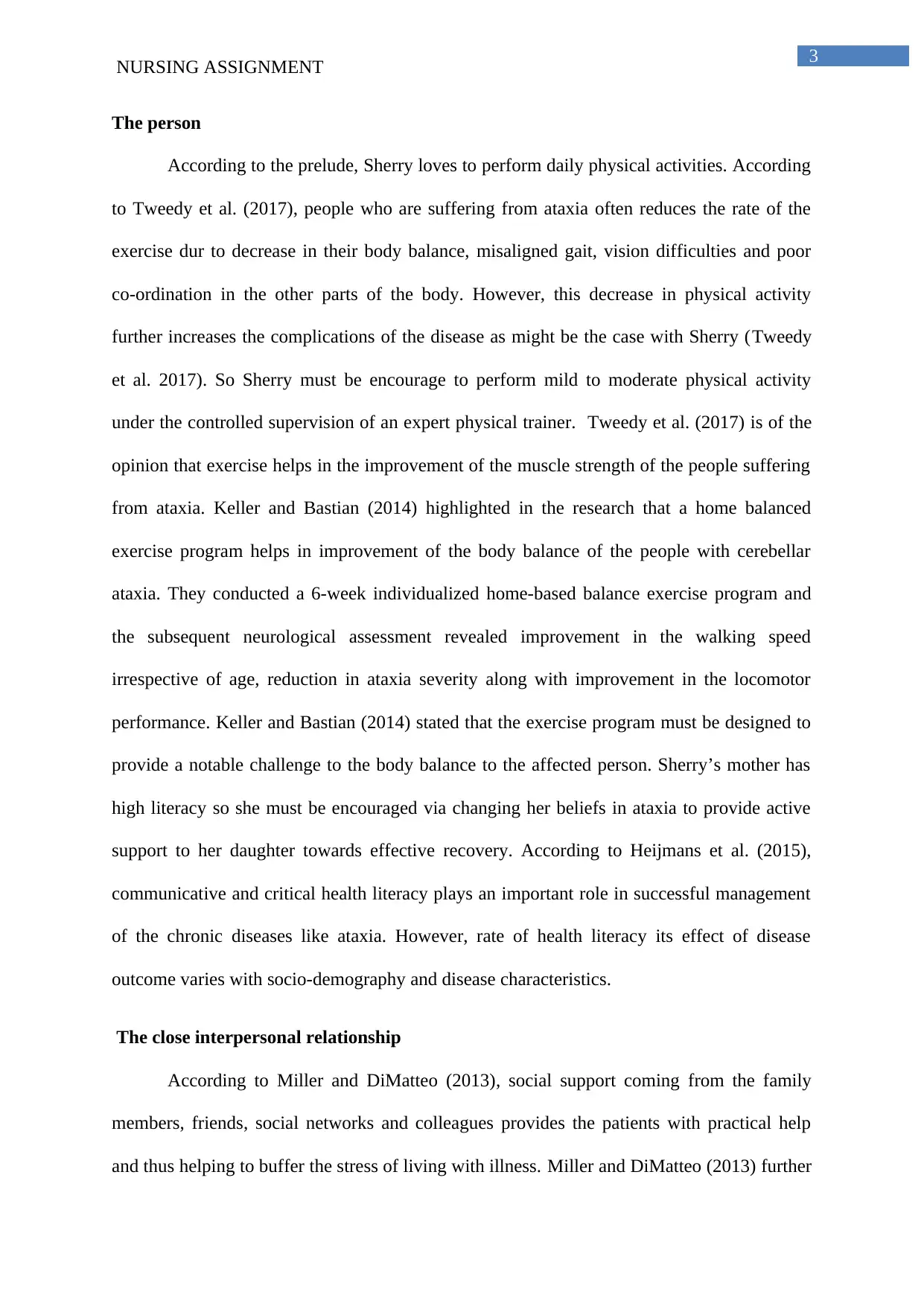
3
NURSING ASSIGNMENT
The person
According to the prelude, Sherry loves to perform daily physical activities. According
to Tweedy et al. (2017), people who are suffering from ataxia often reduces the rate of the
exercise dur to decrease in their body balance, misaligned gait, vision difficulties and poor
co-ordination in the other parts of the body. However, this decrease in physical activity
further increases the complications of the disease as might be the case with Sherry (Tweedy
et al. 2017). So Sherry must be encourage to perform mild to moderate physical activity
under the controlled supervision of an expert physical trainer. Tweedy et al. (2017) is of the
opinion that exercise helps in the improvement of the muscle strength of the people suffering
from ataxia. Keller and Bastian (2014) highlighted in the research that a home balanced
exercise program helps in improvement of the body balance of the people with cerebellar
ataxia. They conducted a 6-week individualized home-based balance exercise program and
the subsequent neurological assessment revealed improvement in the walking speed
irrespective of age, reduction in ataxia severity along with improvement in the locomotor
performance. Keller and Bastian (2014) stated that the exercise program must be designed to
provide a notable challenge to the body balance to the affected person. Sherry’s mother has
high literacy so she must be encouraged via changing her beliefs in ataxia to provide active
support to her daughter towards effective recovery. According to Heijmans et al. (2015),
communicative and critical health literacy plays an important role in successful management
of the chronic diseases like ataxia. However, rate of health literacy its effect of disease
outcome varies with socio-demography and disease characteristics.
The close interpersonal relationship
According to Miller and DiMatteo (2013), social support coming from the family
members, friends, social networks and colleagues provides the patients with practical help
and thus helping to buffer the stress of living with illness. Miller and DiMatteo (2013) further
NURSING ASSIGNMENT
The person
According to the prelude, Sherry loves to perform daily physical activities. According
to Tweedy et al. (2017), people who are suffering from ataxia often reduces the rate of the
exercise dur to decrease in their body balance, misaligned gait, vision difficulties and poor
co-ordination in the other parts of the body. However, this decrease in physical activity
further increases the complications of the disease as might be the case with Sherry (Tweedy
et al. 2017). So Sherry must be encourage to perform mild to moderate physical activity
under the controlled supervision of an expert physical trainer. Tweedy et al. (2017) is of the
opinion that exercise helps in the improvement of the muscle strength of the people suffering
from ataxia. Keller and Bastian (2014) highlighted in the research that a home balanced
exercise program helps in improvement of the body balance of the people with cerebellar
ataxia. They conducted a 6-week individualized home-based balance exercise program and
the subsequent neurological assessment revealed improvement in the walking speed
irrespective of age, reduction in ataxia severity along with improvement in the locomotor
performance. Keller and Bastian (2014) stated that the exercise program must be designed to
provide a notable challenge to the body balance to the affected person. Sherry’s mother has
high literacy so she must be encouraged via changing her beliefs in ataxia to provide active
support to her daughter towards effective recovery. According to Heijmans et al. (2015),
communicative and critical health literacy plays an important role in successful management
of the chronic diseases like ataxia. However, rate of health literacy its effect of disease
outcome varies with socio-demography and disease characteristics.
The close interpersonal relationship
According to Miller and DiMatteo (2013), social support coming from the family
members, friends, social networks and colleagues provides the patients with practical help
and thus helping to buffer the stress of living with illness. Miller and DiMatteo (2013) further
Paraphrase This Document
Need a fresh take? Get an instant paraphrase of this document with our AI Paraphraser
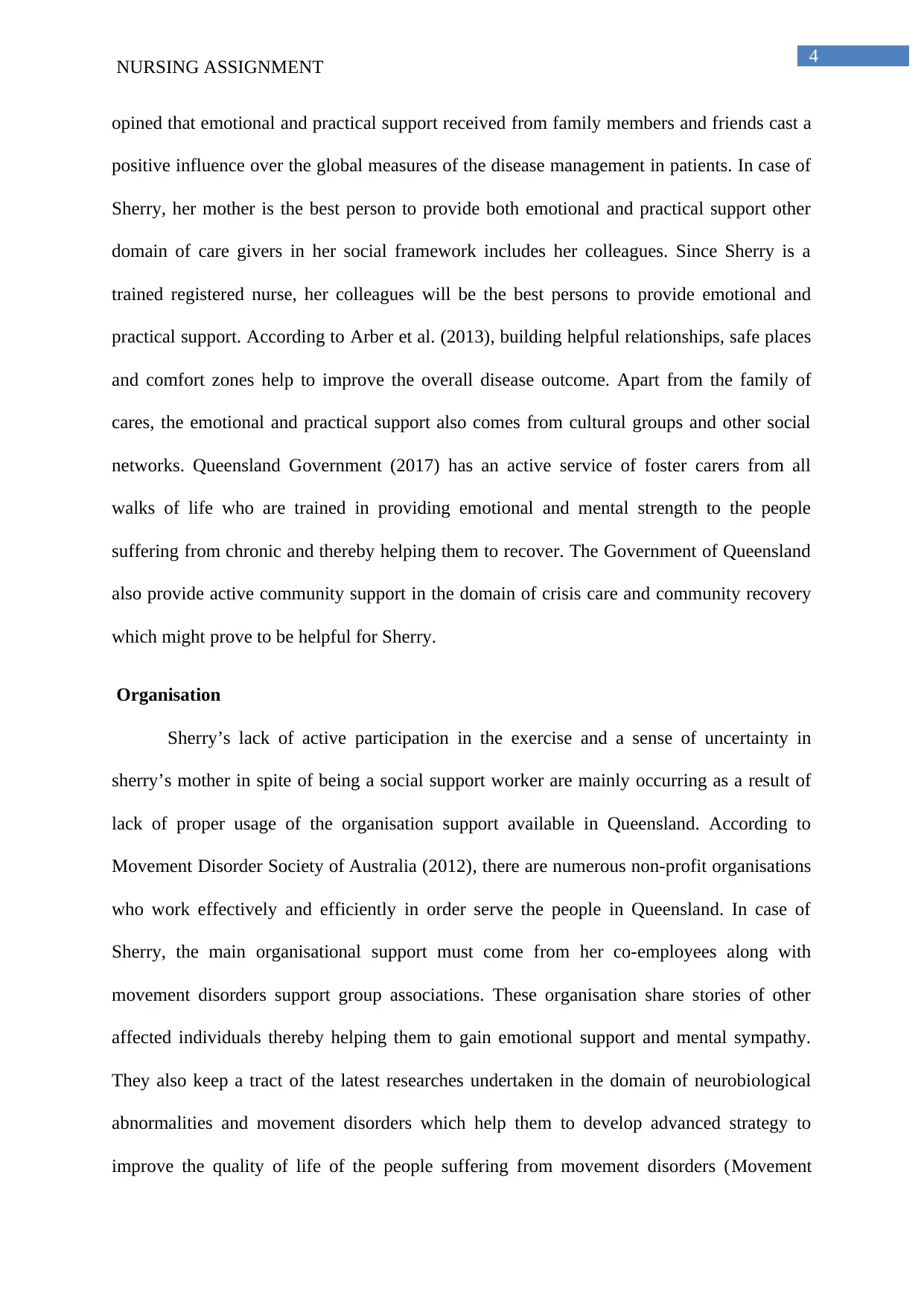
4
NURSING ASSIGNMENT
opined that emotional and practical support received from family members and friends cast a
positive influence over the global measures of the disease management in patients. In case of
Sherry, her mother is the best person to provide both emotional and practical support other
domain of care givers in her social framework includes her colleagues. Since Sherry is a
trained registered nurse, her colleagues will be the best persons to provide emotional and
practical support. According to Arber et al. (2013), building helpful relationships, safe places
and comfort zones help to improve the overall disease outcome. Apart from the family of
cares, the emotional and practical support also comes from cultural groups and other social
networks. Queensland Government (2017) has an active service of foster carers from all
walks of life who are trained in providing emotional and mental strength to the people
suffering from chronic and thereby helping them to recover. The Government of Queensland
also provide active community support in the domain of crisis care and community recovery
which might prove to be helpful for Sherry.
Organisation
Sherry’s lack of active participation in the exercise and a sense of uncertainty in
sherry’s mother in spite of being a social support worker are mainly occurring as a result of
lack of proper usage of the organisation support available in Queensland. According to
Movement Disorder Society of Australia (2012), there are numerous non-profit organisations
who work effectively and efficiently in order serve the people in Queensland. In case of
Sherry, the main organisational support must come from her co-employees along with
movement disorders support group associations. These organisation share stories of other
affected individuals thereby helping them to gain emotional support and mental sympathy.
They also keep a tract of the latest researches undertaken in the domain of neurobiological
abnormalities and movement disorders which help them to develop advanced strategy to
improve the quality of life of the people suffering from movement disorders (Movement
NURSING ASSIGNMENT
opined that emotional and practical support received from family members and friends cast a
positive influence over the global measures of the disease management in patients. In case of
Sherry, her mother is the best person to provide both emotional and practical support other
domain of care givers in her social framework includes her colleagues. Since Sherry is a
trained registered nurse, her colleagues will be the best persons to provide emotional and
practical support. According to Arber et al. (2013), building helpful relationships, safe places
and comfort zones help to improve the overall disease outcome. Apart from the family of
cares, the emotional and practical support also comes from cultural groups and other social
networks. Queensland Government (2017) has an active service of foster carers from all
walks of life who are trained in providing emotional and mental strength to the people
suffering from chronic and thereby helping them to recover. The Government of Queensland
also provide active community support in the domain of crisis care and community recovery
which might prove to be helpful for Sherry.
Organisation
Sherry’s lack of active participation in the exercise and a sense of uncertainty in
sherry’s mother in spite of being a social support worker are mainly occurring as a result of
lack of proper usage of the organisation support available in Queensland. According to
Movement Disorder Society of Australia (2012), there are numerous non-profit organisations
who work effectively and efficiently in order serve the people in Queensland. In case of
Sherry, the main organisational support must come from her co-employees along with
movement disorders support group associations. These organisation share stories of other
affected individuals thereby helping them to gain emotional support and mental sympathy.
They also keep a tract of the latest researches undertaken in the domain of neurobiological
abnormalities and movement disorders which help them to develop advanced strategy to
improve the quality of life of the people suffering from movement disorders (Movement
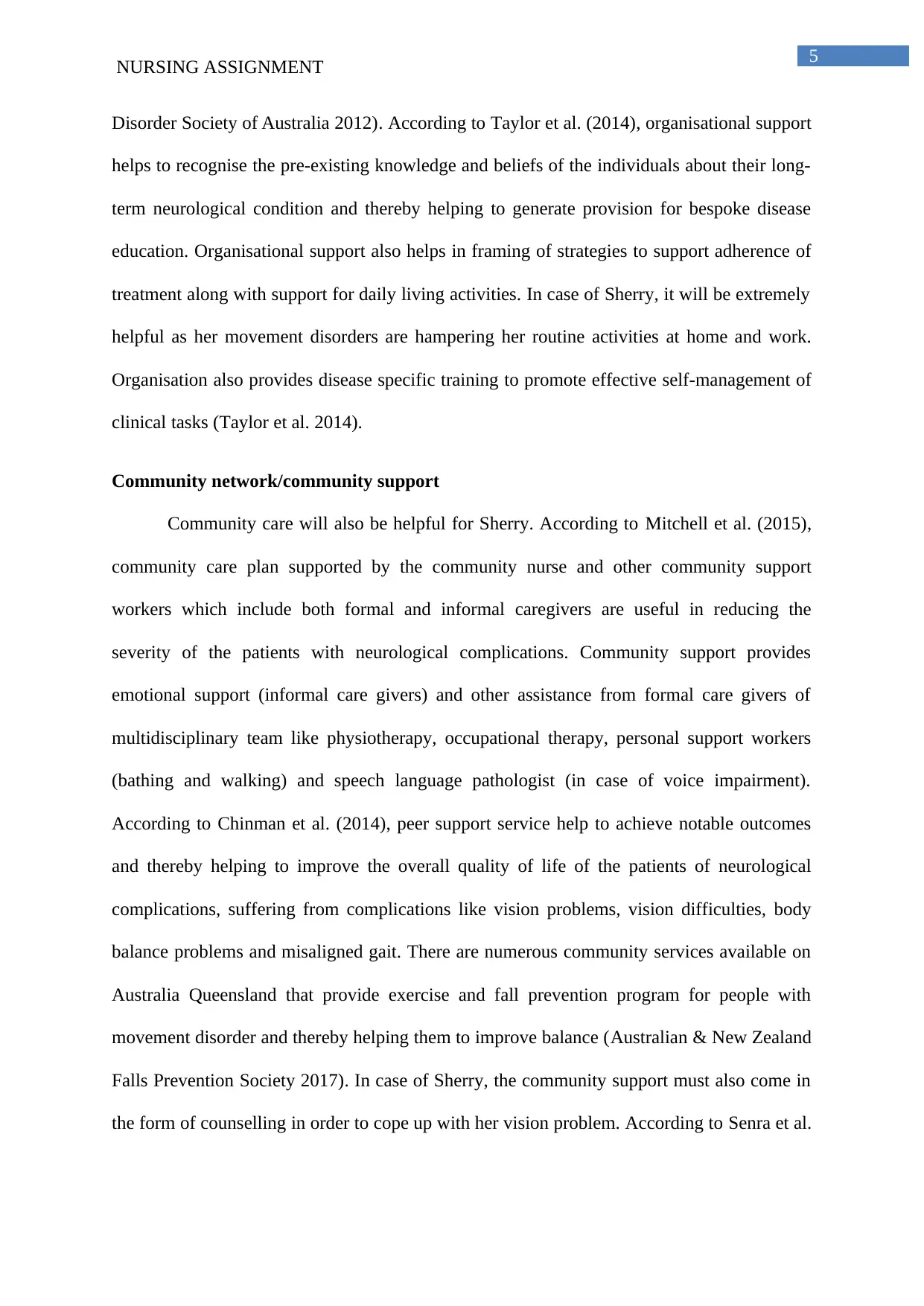
5
NURSING ASSIGNMENT
Disorder Society of Australia 2012). According to Taylor et al. (2014), organisational support
helps to recognise the pre-existing knowledge and beliefs of the individuals about their long-
term neurological condition and thereby helping to generate provision for bespoke disease
education. Organisational support also helps in framing of strategies to support adherence of
treatment along with support for daily living activities. In case of Sherry, it will be extremely
helpful as her movement disorders are hampering her routine activities at home and work.
Organisation also provides disease specific training to promote effective self-management of
clinical tasks (Taylor et al. 2014).
Community network/community support
Community care will also be helpful for Sherry. According to Mitchell et al. (2015),
community care plan supported by the community nurse and other community support
workers which include both formal and informal caregivers are useful in reducing the
severity of the patients with neurological complications. Community support provides
emotional support (informal care givers) and other assistance from formal care givers of
multidisciplinary team like physiotherapy, occupational therapy, personal support workers
(bathing and walking) and speech language pathologist (in case of voice impairment).
According to Chinman et al. (2014), peer support service help to achieve notable outcomes
and thereby helping to improve the overall quality of life of the patients of neurological
complications, suffering from complications like vision problems, vision difficulties, body
balance problems and misaligned gait. There are numerous community services available on
Australia Queensland that provide exercise and fall prevention program for people with
movement disorder and thereby helping them to improve balance (Australian & New Zealand
Falls Prevention Society 2017). In case of Sherry, the community support must also come in
the form of counselling in order to cope up with her vision problem. According to Senra et al.
NURSING ASSIGNMENT
Disorder Society of Australia 2012). According to Taylor et al. (2014), organisational support
helps to recognise the pre-existing knowledge and beliefs of the individuals about their long-
term neurological condition and thereby helping to generate provision for bespoke disease
education. Organisational support also helps in framing of strategies to support adherence of
treatment along with support for daily living activities. In case of Sherry, it will be extremely
helpful as her movement disorders are hampering her routine activities at home and work.
Organisation also provides disease specific training to promote effective self-management of
clinical tasks (Taylor et al. 2014).
Community network/community support
Community care will also be helpful for Sherry. According to Mitchell et al. (2015),
community care plan supported by the community nurse and other community support
workers which include both formal and informal caregivers are useful in reducing the
severity of the patients with neurological complications. Community support provides
emotional support (informal care givers) and other assistance from formal care givers of
multidisciplinary team like physiotherapy, occupational therapy, personal support workers
(bathing and walking) and speech language pathologist (in case of voice impairment).
According to Chinman et al. (2014), peer support service help to achieve notable outcomes
and thereby helping to improve the overall quality of life of the patients of neurological
complications, suffering from complications like vision problems, vision difficulties, body
balance problems and misaligned gait. There are numerous community services available on
Australia Queensland that provide exercise and fall prevention program for people with
movement disorder and thereby helping them to improve balance (Australian & New Zealand
Falls Prevention Society 2017). In case of Sherry, the community support must also come in
the form of counselling in order to cope up with her vision problem. According to Senra et al.
⊘ This is a preview!⊘
Do you want full access?
Subscribe today to unlock all pages.

Trusted by 1+ million students worldwide
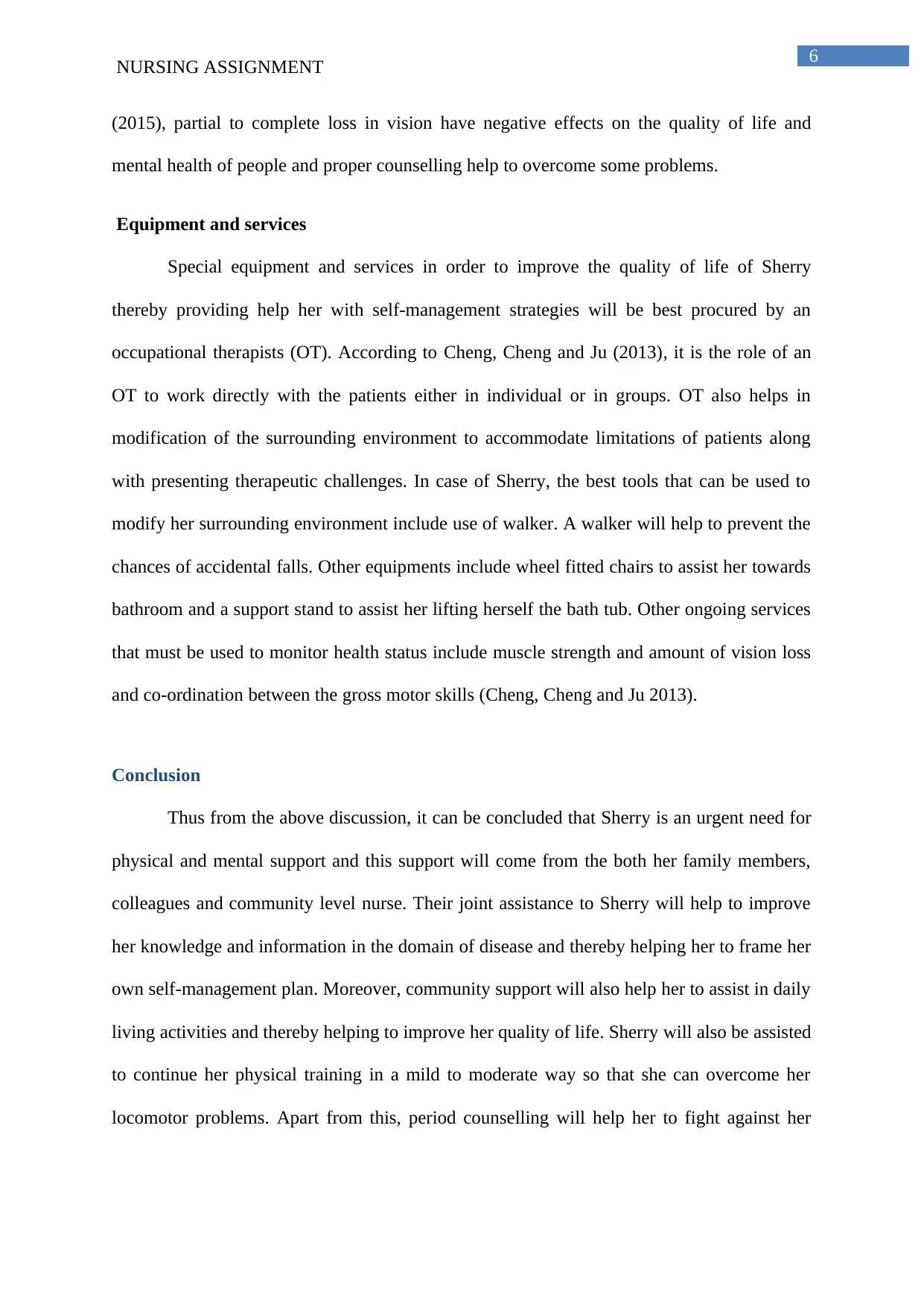
6
NURSING ASSIGNMENT
(2015), partial to complete loss in vision have negative effects on the quality of life and
mental health of people and proper counselling help to overcome some problems.
Equipment and services
Special equipment and services in order to improve the quality of life of Sherry
thereby providing help her with self-management strategies will be best procured by an
occupational therapists (OT). According to Cheng, Cheng and Ju (2013), it is the role of an
OT to work directly with the patients either in individual or in groups. OT also helps in
modification of the surrounding environment to accommodate limitations of patients along
with presenting therapeutic challenges. In case of Sherry, the best tools that can be used to
modify her surrounding environment include use of walker. A walker will help to prevent the
chances of accidental falls. Other equipments include wheel fitted chairs to assist her towards
bathroom and a support stand to assist her lifting herself the bath tub. Other ongoing services
that must be used to monitor health status include muscle strength and amount of vision loss
and co-ordination between the gross motor skills (Cheng, Cheng and Ju 2013).
Conclusion
Thus from the above discussion, it can be concluded that Sherry is an urgent need for
physical and mental support and this support will come from the both her family members,
colleagues and community level nurse. Their joint assistance to Sherry will help to improve
her knowledge and information in the domain of disease and thereby helping her to frame her
own self-management plan. Moreover, community support will also help her to assist in daily
living activities and thereby helping to improve her quality of life. Sherry will also be assisted
to continue her physical training in a mild to moderate way so that she can overcome her
locomotor problems. Apart from this, period counselling will help her to fight against her
NURSING ASSIGNMENT
(2015), partial to complete loss in vision have negative effects on the quality of life and
mental health of people and proper counselling help to overcome some problems.
Equipment and services
Special equipment and services in order to improve the quality of life of Sherry
thereby providing help her with self-management strategies will be best procured by an
occupational therapists (OT). According to Cheng, Cheng and Ju (2013), it is the role of an
OT to work directly with the patients either in individual or in groups. OT also helps in
modification of the surrounding environment to accommodate limitations of patients along
with presenting therapeutic challenges. In case of Sherry, the best tools that can be used to
modify her surrounding environment include use of walker. A walker will help to prevent the
chances of accidental falls. Other equipments include wheel fitted chairs to assist her towards
bathroom and a support stand to assist her lifting herself the bath tub. Other ongoing services
that must be used to monitor health status include muscle strength and amount of vision loss
and co-ordination between the gross motor skills (Cheng, Cheng and Ju 2013).
Conclusion
Thus from the above discussion, it can be concluded that Sherry is an urgent need for
physical and mental support and this support will come from the both her family members,
colleagues and community level nurse. Their joint assistance to Sherry will help to improve
her knowledge and information in the domain of disease and thereby helping her to frame her
own self-management plan. Moreover, community support will also help her to assist in daily
living activities and thereby helping to improve her quality of life. Sherry will also be assisted
to continue her physical training in a mild to moderate way so that she can overcome her
locomotor problems. Apart from this, period counselling will help her to fight against her
Paraphrase This Document
Need a fresh take? Get an instant paraphrase of this document with our AI Paraphraser
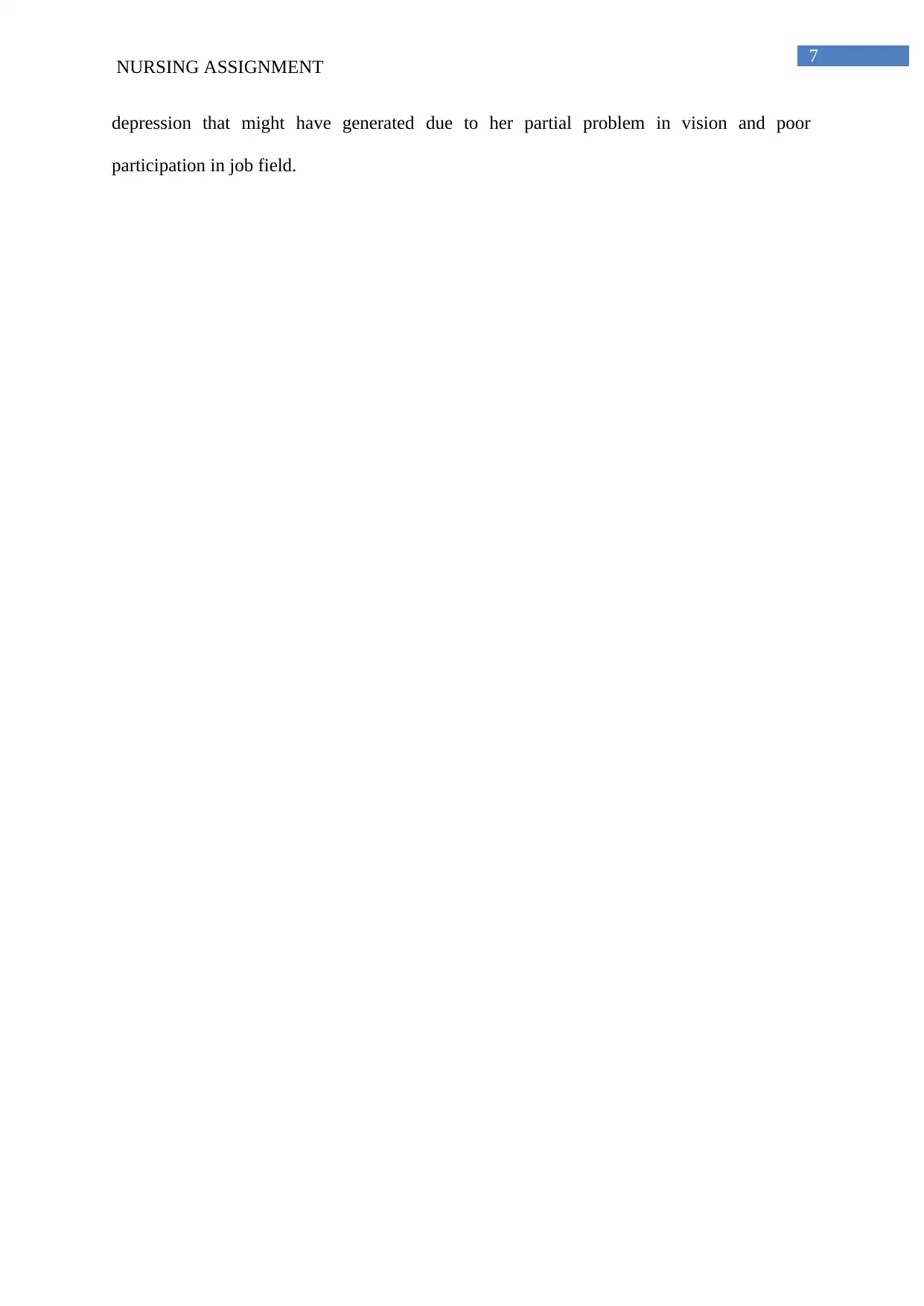
7
NURSING ASSIGNMENT
depression that might have generated due to her partial problem in vision and poor
participation in job field.
NURSING ASSIGNMENT
depression that might have generated due to her partial problem in vision and poor
participation in job field.

8
NURSING ASSIGNMENT
References
Arber, A., Hutson, N., de Vries, K. and Guerrero, D., 2013. Finding the right kind of support:
A study of carers of those with a primary malignant brain tumour. European Journal of
Oncology Nursing, 17(1), pp.52-58.
Australian & New Zealand Falls Prevention Society. 2017. Australian Commission on Safety
and Quality in Healthcare Best Practice Guidelines for Preventing Falls and Harm From
Falls in Older People. Access date: 20th April. Retrieved from:
http://www.anzfallsprevention.org/resources/
Cheng, H.Y.K., Cheng, C.Y. and Ju, Y.Y., 2013. Work-related musculoskeletal disorders and
ergonomic risk factors in early intervention educators. Applied ergonomics, 44(1), pp.134-
141.
Chinman, M., George, P., Dougherty, R.H., Daniels, A.S., Ghose, S.S., Swift, A. and
Delphin-Rittmon, M.E., 2014. Peer support services for individuals with serious mental
illnesses: assessing the evidence. Psychiatric Services, 65(4), pp.429-441.
Corbin, J.M., 1991. A nursing model for chronic illness management based upon the
trajectory framework. Research and Theory for Nursing Practice, 5(3), p.155.
Gatti, R.A. and Painter, R.B. eds., 2013. Ataxia-telangiectasia(Vol. 77). Springer Science &
Business Media.
Heijmans, M., Waverijn, G., Rademakers, J., van der Vaart, R. and Rijken, M., 2015.
Functional, communicative and critical health literacy of chronic disease patients and their
importance for self-management. Patient Education and Counseling, 98(1), pp.41-48.
NURSING ASSIGNMENT
References
Arber, A., Hutson, N., de Vries, K. and Guerrero, D., 2013. Finding the right kind of support:
A study of carers of those with a primary malignant brain tumour. European Journal of
Oncology Nursing, 17(1), pp.52-58.
Australian & New Zealand Falls Prevention Society. 2017. Australian Commission on Safety
and Quality in Healthcare Best Practice Guidelines for Preventing Falls and Harm From
Falls in Older People. Access date: 20th April. Retrieved from:
http://www.anzfallsprevention.org/resources/
Cheng, H.Y.K., Cheng, C.Y. and Ju, Y.Y., 2013. Work-related musculoskeletal disorders and
ergonomic risk factors in early intervention educators. Applied ergonomics, 44(1), pp.134-
141.
Chinman, M., George, P., Dougherty, R.H., Daniels, A.S., Ghose, S.S., Swift, A. and
Delphin-Rittmon, M.E., 2014. Peer support services for individuals with serious mental
illnesses: assessing the evidence. Psychiatric Services, 65(4), pp.429-441.
Corbin, J.M., 1991. A nursing model for chronic illness management based upon the
trajectory framework. Research and Theory for Nursing Practice, 5(3), p.155.
Gatti, R.A. and Painter, R.B. eds., 2013. Ataxia-telangiectasia(Vol. 77). Springer Science &
Business Media.
Heijmans, M., Waverijn, G., Rademakers, J., van der Vaart, R. and Rijken, M., 2015.
Functional, communicative and critical health literacy of chronic disease patients and their
importance for self-management. Patient Education and Counseling, 98(1), pp.41-48.
⊘ This is a preview!⊘
Do you want full access?
Subscribe today to unlock all pages.

Trusted by 1+ million students worldwide

9
NURSING ASSIGNMENT
Keller, J.L. and Bastian, A.J., 2014. A home balance exercise program improves walking in
people with cerebellar ataxia. Neurorehabilitation and neural repair, 28(8), pp.770-778.
Miller, T.A. and DiMatteo, M.R., 2013. Importance of family/social support and impact on
adherence to diabetic therapy. Diabetes, metabolic syndrome and obesity: targets and
therapy, 6, p.421.
Mitchell, L.A., Hirdes, J., Poss, J.W., Slegers-Boyd, C., Caldarelli, H. and Martin, L., 2015.
Informal caregivers of clients with neurological conditions: profiles, patterns and risk factors
for distress from a home care prevalence study. BMC health services research, 15(1), p.350.
Movement Disorder Society of Australia. 2012. The Biannual Movement Disorder Society of
Australia and New Zealand Conference
Melbourne, Australia - September 8-10, 2011. Access date: 20th April. Retrieved from:
https://www.movementdisorders.org/MDS/AOS-Partners/Movement-Disorder-Society-of-
Australia.htm
O’donoghue, G., Perchoux, C., Mensah, K., Lakerveld, J., Van Der Ploeg, H., Bernaards, C.,
Chastin, S.F., Simon, C., O’gorman, D. and Nazare, J.A., 2016. A systematic review of
correlates of sedentary behaviour in adults aged 18–65 years: a socio-ecological
approach. BMC public health, 16(1), p.163.
Queensland Government. 2017. Community Support. Access date: 20th April. Retrieved from:
https://www.qld.gov.au/community
Senra, H., Barbosa, F., Ferreira, P., Vieira, C.R., Perrin, P.B., Rogers, H., Rivera, D. and
Leal, I., 2015. Psychologic adjustment to irreversible vision loss in adults: a systematic
review. Ophthalmology, 122(4), pp.851-861.
NURSING ASSIGNMENT
Keller, J.L. and Bastian, A.J., 2014. A home balance exercise program improves walking in
people with cerebellar ataxia. Neurorehabilitation and neural repair, 28(8), pp.770-778.
Miller, T.A. and DiMatteo, M.R., 2013. Importance of family/social support and impact on
adherence to diabetic therapy. Diabetes, metabolic syndrome and obesity: targets and
therapy, 6, p.421.
Mitchell, L.A., Hirdes, J., Poss, J.W., Slegers-Boyd, C., Caldarelli, H. and Martin, L., 2015.
Informal caregivers of clients with neurological conditions: profiles, patterns and risk factors
for distress from a home care prevalence study. BMC health services research, 15(1), p.350.
Movement Disorder Society of Australia. 2012. The Biannual Movement Disorder Society of
Australia and New Zealand Conference
Melbourne, Australia - September 8-10, 2011. Access date: 20th April. Retrieved from:
https://www.movementdisorders.org/MDS/AOS-Partners/Movement-Disorder-Society-of-
Australia.htm
O’donoghue, G., Perchoux, C., Mensah, K., Lakerveld, J., Van Der Ploeg, H., Bernaards, C.,
Chastin, S.F., Simon, C., O’gorman, D. and Nazare, J.A., 2016. A systematic review of
correlates of sedentary behaviour in adults aged 18–65 years: a socio-ecological
approach. BMC public health, 16(1), p.163.
Queensland Government. 2017. Community Support. Access date: 20th April. Retrieved from:
https://www.qld.gov.au/community
Senra, H., Barbosa, F., Ferreira, P., Vieira, C.R., Perrin, P.B., Rogers, H., Rivera, D. and
Leal, I., 2015. Psychologic adjustment to irreversible vision loss in adults: a systematic
review. Ophthalmology, 122(4), pp.851-861.
Paraphrase This Document
Need a fresh take? Get an instant paraphrase of this document with our AI Paraphraser

10
NURSING ASSIGNMENT
Taylor, S.J., Pinnock, H., Epiphaniou, E., Pearce, G., Parke, H.L., Schwappach, A.,
Purushotham, N., Jacob, S., Griffiths, C.J., Greenhalgh, T. and Sheikh, A., 2014. A rapid
synthesis of the evidence on interventions supporting self-management for people with long-
term conditions: PRISMS–Practical systematic Review of Self-Management Support for
long-term conditions.
Tweedy, S.M., Beckman, E.M., Geraghty, T.J., Theisen, D., Perret, C., Harvey, L.A. and
Vanlandewijck, Y.C., 2017. Exercise and sports science Australia (ESSA) position statement
on exercise and spinal cord injury. Journal of science and medicine in sport, 20(2), pp.108-
115.
NURSING ASSIGNMENT
Taylor, S.J., Pinnock, H., Epiphaniou, E., Pearce, G., Parke, H.L., Schwappach, A.,
Purushotham, N., Jacob, S., Griffiths, C.J., Greenhalgh, T. and Sheikh, A., 2014. A rapid
synthesis of the evidence on interventions supporting self-management for people with long-
term conditions: PRISMS–Practical systematic Review of Self-Management Support for
long-term conditions.
Tweedy, S.M., Beckman, E.M., Geraghty, T.J., Theisen, D., Perret, C., Harvey, L.A. and
Vanlandewijck, Y.C., 2017. Exercise and sports science Australia (ESSA) position statement
on exercise and spinal cord injury. Journal of science and medicine in sport, 20(2), pp.108-
115.
1 out of 11
Your All-in-One AI-Powered Toolkit for Academic Success.
+13062052269
info@desklib.com
Available 24*7 on WhatsApp / Email
![[object Object]](/_next/static/media/star-bottom.7253800d.svg)
Unlock your academic potential
Copyright © 2020–2025 A2Z Services. All Rights Reserved. Developed and managed by ZUCOL.

